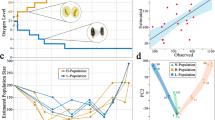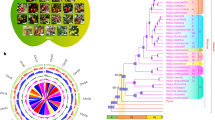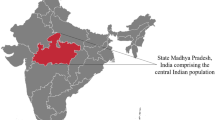Abstract
High resolution electrophoretic analyses of the polymorphic esterase 6 enzyme have been carried out on 133 isoallelic lines from three Australian populations of Drosophila melanogaster spanning 25° of latitude. These and previous data for 157 lines from another Australian population at an intermediate latitude reveal a total of 14 polymorphic esterase 6 allozymes, falling into five major mobility classes. Two classes, EST6-F and EST6-S, contain eleven of the allozymes but one allozyme, EST6-8 within the EST6-S class, is several times more common than any other. Variation in the frequency of this single allozyme can explain most of the latitudinal clines previously reported for the major EST6-F and EST6-S classes. Thermostability analyses of 52 of the Australian lines and 13 American lines reveal at least seven more EST6 variants within five of the allozymes, bringing the total number of variants to at least 21. Of the six allozymes for which more than one line was subjected to thermostability analyses, only EST6-8 could not be partitioned into additional variants. This corroborates a previous finding that two different isolates of the Est6-8 allele have identical DNA sequences and suggests that this allele, although now the most common, has nevertheless arisen relatively recently.
Similar content being viewed by others
Article PDF
References
Abedin, K, McNamara, S, Osterbur, D, and Steiner, W W M. 1980. Studies on the effect of temperature on fitness and fecundity at the esterase 6 locus in D. melanogaster. Drosophila Inform Serv, 55, 10–11.
Akam, M E, Roberts, D B, Richards, G P, and Ashburner, M. 1978. Drosophila: the genetics of two major larval proteins. Cell, 13, 215–225.
Anderson, P R, and Oakeshott, J G. 1984. Parallel geographic patterns of allozyme variation in two sibling Drosophila species. Nature, 308, 729–731.
Aslund, S E, and Rasmuson, M. 1976. Mating behaviour as a fitness component in maintaining allozyme polymorphism in Drosophila melanogaster. Hereditas, 82, 175–178.
Cochrane, B J, and Richmond, R C. 1979. Studies of esterase 6 in Drosophila melanogaster. II. The genetics and frequency distributions of naturally occurring variants studied by electrophoretic and heat stability criteria. Genetics, 93, 461–478.
Cooke, P H, and Oakeshott, J G. 1988. Amino acid polymorphisms for esterase 6 in Drosophila melanogaster. Proc Natl Acad Sci USA (In press).
Cooke, P H, Richmond, R C, and Oakeshott, J G. 1987. High resolution electrophoretic variation at the esterase 6 locus in a natural population of Drosophila melanogaster. Heredity, 59, 259–264.
Danford, N D, and Beardmore, J A. 1979. Biochemical properties of esterase 6 in Drosophila melanogaster. Biochem Genet, 17, 1–22.
Game, A Y, and Oakeshott, J G. 1989. Variation in the activity and amount of esterase 6 in a natural population of Drosophila melanogaster. Heredity, 62, 27–34.
Lindsley, D L, and Grell, E H. 1968. Genetic Variations of Drosophila melanogaster. Carnegie Institute, Washington.472pp.
Minawa, A, and Birley, A J. 1978. The genetical response to natural selection by varied environments. I. Short-term observations. Heredity, 40, 39–50.
Oakeshott, J G. 1979. Selection affecting enzyme polymorphisms in natural populations of Drosophila melanogaster. Oecologia, 43, 341–354.
Oakeshott, J G, Chambers, G K, Gibson, J B, and Willcocks, D A. 1981. Latitudinal relationships of esterase 6 and phosphoglucomutase gene frequencies in Drosophila melanogaster. Heredity, 47, 385–396.
Sheehan, K, Richmond, R C, and Cochrane, B J. 1979. Studies of esterase 6 in Drosophila melanogaster. III. The developmental pattern and tissue distribution. Insect Biochem, 9, 443–450.
White, M M, Mane, S D, and Richmond, R C. 1988. Studies of esterase 6 in Drosophila melanogaster. XVIII. Biochemical differences between the slow and fast allozymes. Mol Biol Evol, 5, 41–62.
Author information
Authors and Affiliations
Rights and permissions
About this article
Cite this article
Labate, J., Bortoli, A., Game, A. et al. The number and distribution of esterase 6 alleles in populations of Drosophila melanogaster. Heredity 63, 203–208 (1989). https://doi.org/10.1038/hdy.1989.93
Received:
Issue date:
DOI: https://doi.org/10.1038/hdy.1989.93
This article is cited by
-
Esterase profile of Rhipicephalus (Boophilus) microplus populations collected from Northern India exhibiting varied susceptibility to deltamethrin
Experimental and Applied Acarology (2012)
-
Latitudinal clines for nucleotide polymorphisms in the Esterase 6 gene of Drosophila melanogaster
Genetica (2007)
-
Causes and consequences of esterase 6 enzyme activity variation in pre-adult Drosophila melanogaster
Heredity (1994)
-
Associations of esterase 6 allozyme and activity variation with reproductive fitness inDrosophila melanogaster
Genetica (1994)
-
Sequential gel electrophoretic analysis of esterase-2 in two populations of Drosophila buzzatii
Genetica (1994)



